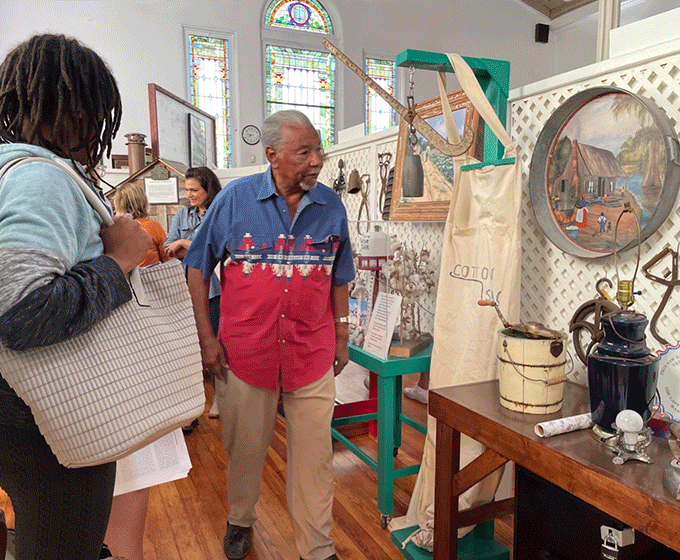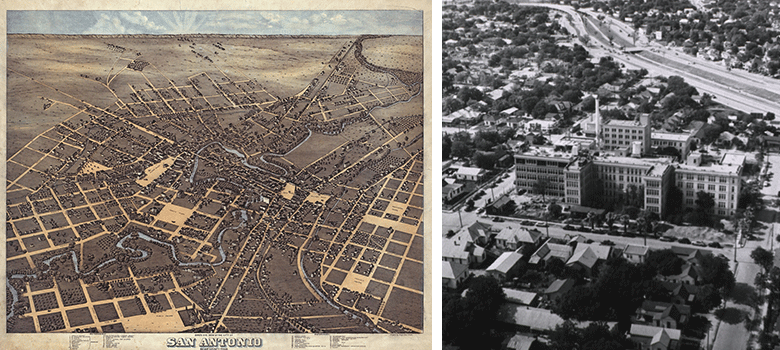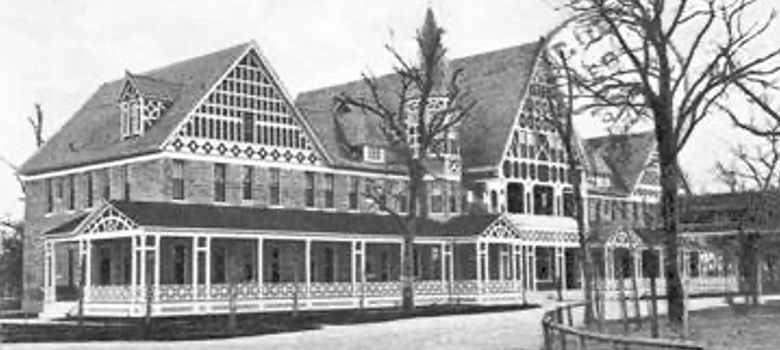
Charles Williams leading a group of teachers on a Seed of Texas Walking Tour through the Williams Historical Museum, a museum which highlights local African American history.
MAY 23, 2025 — UTSA researchers and Bexar County are advancing their collaborative work to produce the most expansive and comprehensive digital history of the region, the Seed of Texas. The newly released third installment of the site, "Boom and Bust,” chronicles the history of the city from its commercial boom following the construction of the railroad in 1877 through the end of World War II in 1945.
Initially launched in commemoration of Bexar County’s 300th anniversary celebration, the ambitious project includes four phases. Once completed, it will span 12,000 years of the area’s history, beginning in prehistoric times, encompassing the periods before and after the Ice Age and the emergence of the earliest human settlements. The final component of the project, set to be released in 2028, will progress to the present day.
Phases 1-3 of the project are available on the website, which is designed for curious locals, tourists, researchers and students. Lesson plans for fourth and seventh grade allow educators to bring San Antonio’s history to life in the classroom.

Left: A bird’s eye view of downtown San Antonio in 1873 by Augustus Koch. Right: The Robert B. Green hospital, date unknown.
Jessica Nowlin, principal investigator and UTSA assistant professor of classics said that this retelling of the city’s history is unique in its scope, interactivity and visual components.
“The goal of the project is to help tell Bexar County's history through interactive digital maps and take primary source documents that have not been typically accessible to the public and make them accessible,” she said.
Nowlin applied her expertise in Geographic Information Services (GIS) to create the interactive maps, which she believes help people feel more personally connected to history.
“Teachers tell us it's really hard for students to understand how history relates to their everyday lives or where they live today. These maps are really helpful for showing people that there are historic locations right around the corner from where you live, work or go get coffee,” she said.
The research has unearthed some unexpected threads in the city’s history — stories that were previously overlooked or possibly suppressed.
“There's so much more to Bexar County's history than the Alamo. There are really amazing histories of medicine, activism, different community groups and different businesses, like the brewery industry. Many groups have a deep history here in San Antonio dating back to the end of the 19th century. A lot of these modules can really help explain why San Antonio and Bexar County look the way they do today,” Nowlin said.

The hot wells, a popular tourist attraction, photographed in 1907. Photo Courtesy of UTSA Special Collections.
The site offers a medical history of the city, sharing insights into various disease outbreaks in a section titled “The Public Health Movement.” One revelation was the prevalence of tuberculosis.
“The United States Public Health Services conducted a study in 1942 and found that one in every 20 Mexican and Mexican American San Antonio residents had tuberculosis,” Nowlin said.
This was five times higher than the general American population at the time.
The scale of the problem had gone unrecognized prior to this. San Antonio was largely seen as a wellness sanctuary, with many northerners visiting the city to bathe in the hot wells and recuperate from illness.
“That would certainly put a damper on the tourism industry if you were told that tuberculosis, which you're trying to flee from in the North, is actually a serious problem here in San Antonio,” she added.
These findings prompted several activists to advocate for improved public housing and on-site health clinics. Health initiatives like Movimiento Pro Salud promoted the dissemination of health information in newspapers and films, enabling the city to dramatically cut the rate of TB.
Nowlin is looking forward to building the fourth and final chapter of the site, which will bring the saga of San Antonio up to present day and explore the area's recent struggles and triumphs, including downtown developments such as the Riverwalk and the origin story of Fiesta.
While the comprehensive history can be explored virtually on the site, many key artifacts and interactive elements from the research can also be viewed in-person at the Bexar Heritage Center.
UTSA Today is produced by University Communications and Marketing, the official news source of The University of Texas at San Antonio. Send your feedback to news@utsa.edu. Keep up-to-date on UTSA news by visiting UTSA Today. Connect with UTSA online at Facebook, Twitter, Youtube and Instagram.
Move-in Day is an exciting time for incoming students. Students living in Chaparral Village move in from August 20-21. The UTSA Housing and Residence Life (HRL) team looks forward to welcoming you all and helping you settle into your room.
Chaparral VillageMove-in Day is an exciting time for incoming students. Students living in Laurel Village move in on August 22. The UTSA Housing and Residence Life (HRL) team looks forward to welcoming you all and helping you settle into your room.
Laurel VillageThe College of Sciences welcomes our newest Roadrunners to UTSA at VIVA Science! This interactive event connects students with faculty, staff, student leaders, and peers while highlighting the opportunities available across the College.
Outdoor Learning Environment 2 (OLE), Flawn Building, Main CampusWe're excited to welcome the new class of UTSA College of Liberal and Fine Arts (COLFA) students to campus! Move In To COLFA is strongly recommended for new students in COLFA because it gives you the chance to learn about the Student Success Center, learn how to do college successfully and meet new friends.
Galleria (MH 2.01), McKinney Humanities Building, Main CampusBuild connections with your Alvarez College of Business peers and learn more about the Career Compass program! This opportunity will provide fun interactions, giveaways and a chance to meet your next friend!
Richard Liu Auditorium (BB 2.01.02,) Business Building, Main CampusCelebrate the end of summer and the start off a great fall semester with The Housing Block Party! This event will have live music, carnival-style treats, artists, games, and activities galore. Come and join us for a night of fun!
Multipurpose Room/Lawn, Guadalupe Hall, Main CampusBe part of an unforgettable night as SOSA takes the field for its first public performance of the season! Experience the power, pride, and pageantry of UTSA’s marching band. Learn beloved traditions, practice cheers, and feel what it means to be a Roadrunner.
Campus Rec FieldsThe University of Texas at San Antonio is dedicated to the advancement of knowledge through research and discovery, teaching and learning, community engagement and public service. As an institution of access and excellence, UTSA embraces multicultural traditions and serves as a center for intellectual and creative resources as well as a catalyst for socioeconomic development and the commercialization of intellectual property - for Texas, the nation and the world.
To be a premier public research university, providing access to educational excellence and preparing citizen leaders for the global environment.
We encourage an environment of dialogue and discovery, where integrity, excellence, respect, collaboration and innovation are fostered.